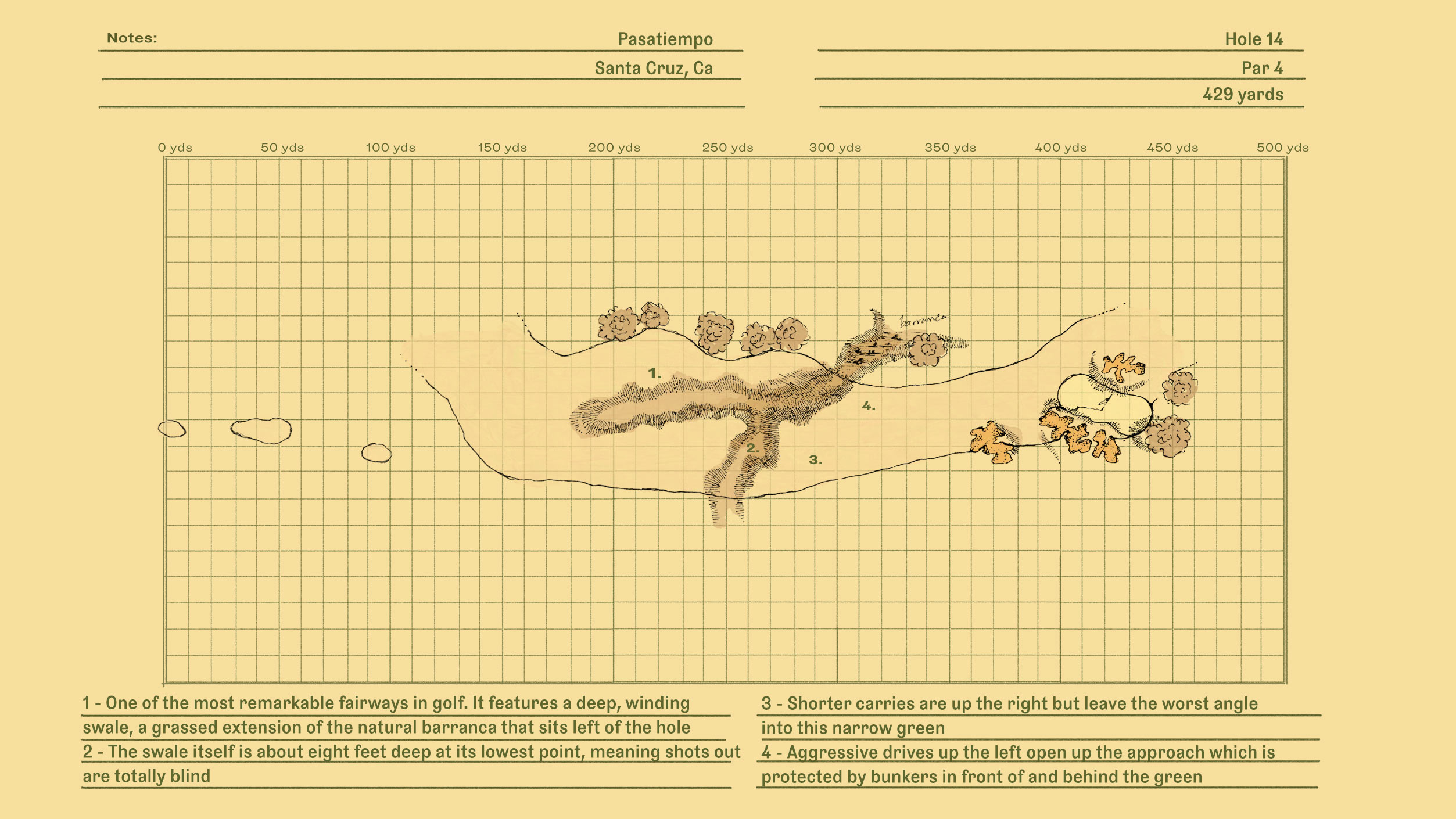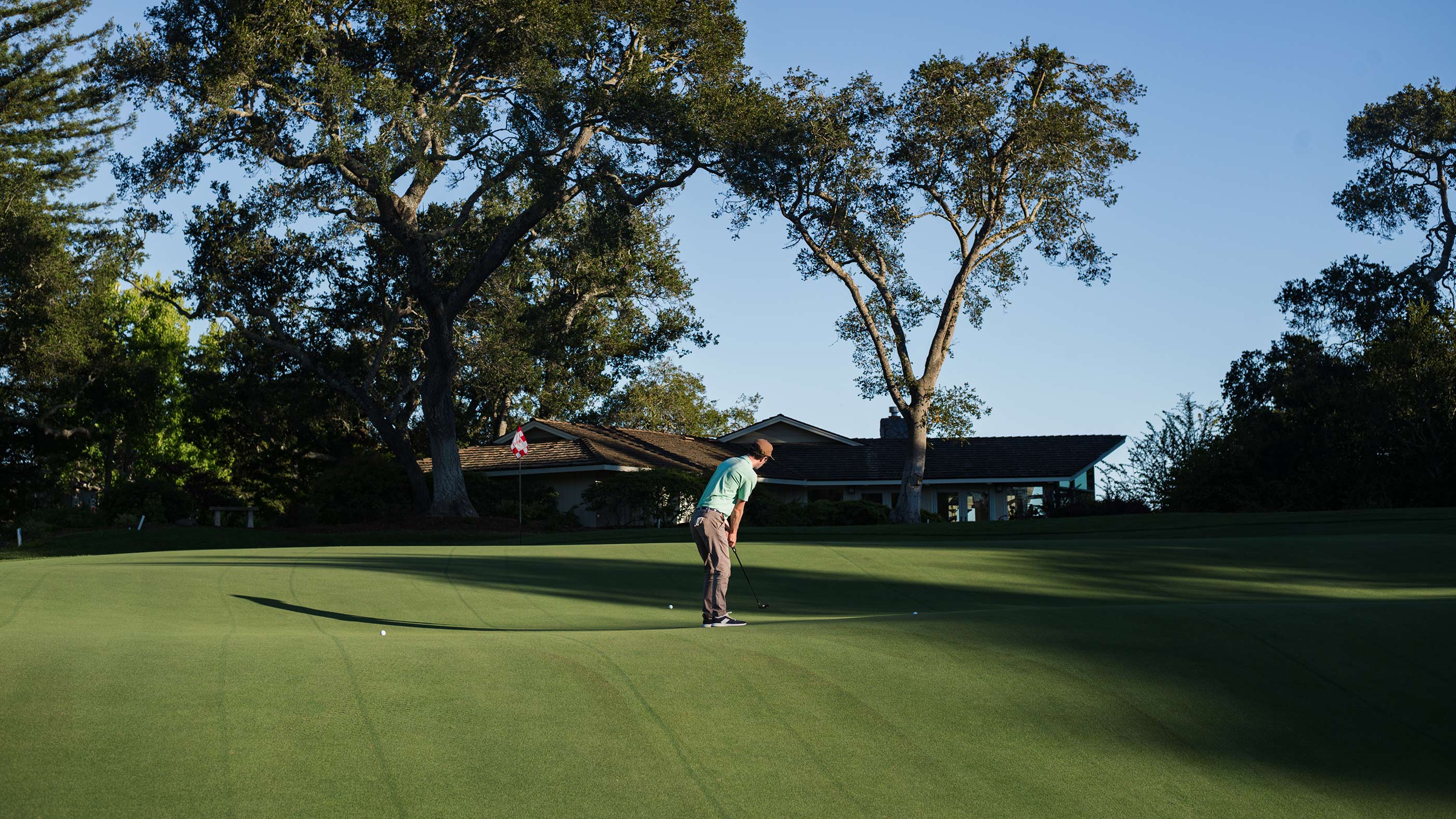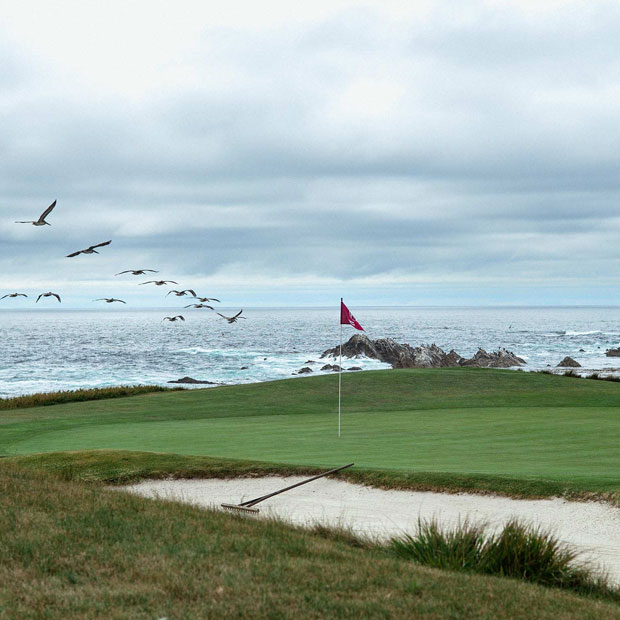Pasatiempo Golf Club
Alister MacKenzie's brilliant architecture at Pasatiempo matches the scale and drama of the property in the foothills above Santa Cruz, California

Santa Cruz, California, USA
Alister MacKenzie (original design, 1929)
Semi-Private
$$$
Alister MacKenzie's Pasatiempo | Fried Egg Guides
The most interesting fairway in golf: The 14th at Pasatiempo
Pasatiempo Is So, So Good
Alongside Pinehurst No. 2, Pasatiempo Golf Club occupies an important position in American golf: it is a first-rate, well-preserved Golden Age course that all golfers willing to pay the green fee can see and enjoy for themselves.
Pasatiempo’s relative accessibility is a fluke of history. Initially, founder Marion Hollins, the 1921 U.S. Women’s Amateur champion and athletic director for Samuel F.B. Morse’s Del Monte Properties, conceived of the club as a private real estate development and sports complex. She hired Alister MacKenzie, whom she had previously tabbed to design Cypress Point, to build an 18-hole championship course in the hills above Santa Cruz, California. MacKenzie’s architecture lives up to the drama of the land. The front nine plunges downhill, toward a striking view of the Pacific Ocean, before climbing back to the clubhouse, while the back nine winds through a beautiful, barranca-striped canyon. MacKenzie’s greens are equally responsive to the splendor of the property: they are big and adventurously contoured, with tendrils curling around large, flashed bunkers. When Pasatiempo opened on September 8, 1929, it must have been one of the most magnificent courses in the world. Six weeks later, however, its future was thrown into doubt when the U.S. stock market crashed. By the 1940s, Pasatiempo had become reliant on daily fees from non-members. Ever since, it has operated on a “semi-private” model, setting aside a generous number of tee times for the public.
In recent decades, with its finances secure, Pasatiempo has focused on restoring its Alister MacKenzie design. The club hired Tom Doak as consulting architect in 1996, and along with his lead associate Jim Urbina, Doak oversaw a decade’s worth of tree removal, bunker restoration, and green expansions. In 2023 and 2024, Urbina led another historically informed project, rebuilding all of the course’s greens and bunkers. Today’s Pasatiempo strongly resembles the 1929 original, though its presentation has grown markedly less rustic.
Take Note…
A star-studded debut. Marion Hollins knew how to throw a party. The first group to play Pasatiempo on its opening day in September 1929 consisted of Hollins herself; Glenna Collett, six-time U.S. Women’s Amateur champion; Cyril Tolley, two-time British Amateur champion; and Bobby Jones, who would win the Grand Slam the next year. During the festivities, Jones met Alister MacKenzie. Later, the pair collaborated on the design of Augusta National Golf Club. Julian P. Graham’s photographs of this day of this day in the Santa Cruz Mountains are among the loveliest golf images ever produced.
Casa de MacKenzie. MacKenzie clearly took a liking to Pasatiempo: he purchased a home next to the sixth fairway and died there of a heart attack in 1934. The handsome clapboard house hasn’t changed much over the years, and its location is indicated by a plaque set into a cart path, which reads:
“Home of the Famous Golf Course Architect
Dr. Alister MacKenzie
1930-1934
Designer of Pasatiempo Golf Course, Cypress Point, Augusta National and Royal Melbourne
‘It is the successful negotiation of difficulties, or what appears to be such, which gives rise to pleasurable excitement and makes a hole interesting.’ -A. MacKenzie.”
Passing the tiempo. For my money, Pasatiempo is the best-named golf course in America. The word “pasatiempo” translates literally to “pastime” or “hobby,” but as the Alister MacKenzie Society notes in this write-up, it also carries a meaning closer to “relaxed passage of time.” This is an apt description of how it feels to spend a day at Pasatiempo.
California water. Over the past 15 years, Pasatiempo has significantly reduced its reliance on potable (i.e., drinking-quality) water. In 2010, the course reduced its turf acreage by 25%, and starting in 2017, it began using treated wastewater pumped from the mountain town of Scotts Valley.
{{pasatiempo-about-gallery}}
Favorite Hole
No. 14, par 4, 427 yards
The 14th at Pasatiempo is the flattest hole on the course. Both the tee and the green sit on fairly bland pieces of ground. What arrests the player’s attention, then, is a big topographical feature in the fairway: an eight- to 10-foot-deep grassed-over gully—a tributary of the neighboring barranca—smack in the middle of the landing zone for tee shots. This leaves a few options. You can 1) aim for the high ground on the right half of the fairway, leaving yourself a hefty approach from a poor angle over the front-right green-side bunkers; 2) go straight for the gully, where you’ll encounter a blind but slightly shorter second shot from a decent angle; or 3) if you have the power, try to carry the hazard entirely and gain the ideal position.
(One nitpick: I wish the fairway were wider on the right side, allowing more room for the first option. Right now, the hole almost forces players into the trough. Unfortunately, though, since houses line the right side of the hole corridor, a fairway expansion is unlikely.)
Favorite Hole
No. 14, par 4, 427 yards
The 14th at Pasatiempo is the flattest hole on the course. Both the tee and the green sit on fairly bland pieces of ground. What arrests the player’s attention, then, is a big topographical feature in the fairway: an eight- to 10-foot-deep grassed-over gully—a tributary of the neighboring barranca—smack in the middle of the landing zone for tee shots. You are left with a few options. You can 1) aim for the high ground on the right half of the fairway, leaving yourself a hefty approach from a poor angle over the front-right green-side bunkers; 2) go straight for the gully, where you’ll encounter a blind but slightly shorter second shot from a decent angle; or 3) if you have the power, try to carry the hazard entirely and gain the ideal position.
(One nitpick: I wish the fairway were wider on the right side, allowing more room for the first option. Right now, the hole almost forces players into the trough. Unfortunately, though, since houses line the right side of the hole corridor, a fairway expansion is unlikely.)

{{pasatiempo-favorite-hole-gallery}}
Overall Thoughts
Artists tend to take fewer risks as they get older. As they learn their strengths, many of them become more consistent and stylistically defined. This isn’t always a bad thing. A loss in adventurousness may be offset by gains in wisdom and craftsmanship. Consider the late-career work of Bob Dylan. 2001’s Love and Theft and 2006’s Modern Times lack the revolutionary spark of his 1960s albums, but they are exceptionally well written, performed, and recorded. Dylan is no longer the Voice of a Generation, but he has become an outstanding bandleader.
Another, perhaps rarer type of artist grows more experimental with age. Think of Beethoven, James Joyce, and David Lynch, all of whom finished their careers with blasts of deep weirdness (the late string quartets, Finnegans Wake, and the third season of Twin Peaks, respectively).
Golf architects tend to be more Dylan-like than Lynchian in their career trajectories. This is partly because golf architecture is a conservative art form, funded by clients who assume a lot of financial risk and don’t usually have much tolerance for artistic flights of fancy. Experienced designers know how hard it is to persuade a developer to back a new and untested type of golf course, and many just stop trying.
Alister MacKenzie was an exception. Whether because of his own restless, forceful personality, or because he happened to work with forward-looking patrons like Marion Hollins and Bobby Jones, MacKenzie became more daring in his approach to his craft toward the end of his career. The final projects he completed before his death in 1934—Pasatiempo, various designs in South America, and Augusta National—are among his most unorthodox. Sadly, almost all of his courses in Argentina and Uruguay have either been lost or altered beyond recognition, and Augusta National, while still a great championship venue, has pursued modernization more than restoration. Pasatiempo, therefore, stands alone as a well-preserved example of MacKenzie’s experimental late work.
The course bucks all manner of architectural conventions. It ends with a par 3, and on opening day in 1929, the front nine featured four par 5s (1, 2, 6, and 9) and three par 3s (3, 5, and 8). At least two holes—the par-3 third and par-4 11th, both long and uphill, with narrow, well-protected greens—are more difficult than anything most current golf architects would dare to build.
{{pasatiempo-conventions-gallery}}
Even the act of putting a golf course on this piece of land was audacious. From the 12th tee to the second green, the property falls about 300 feet. (“That's the most elevation I can think of in any Golden Age course meant to be walked,” the club’s former consulting architect Tom Doak once said on Golf Club Atlas.) It is a testament to MacKenzie’s routing prowess that Pasatiempo remains a pleasurable, if vigorous, walk. No two holes in a row travel significantly uphill, and the toughest hikes are spaced out, coming at the third, ninth, 11th, and 17th holes.
But MacKenzie saved his boldest moves for Pasatiempo’s greens. Never before had he designed a full set of putting surfaces so strangely shaped and wildly contoured. From above, many of them look like amoebas, with little arms stretching out from a central glob. Because of the steepness of the property, several green sites at Pasatiempo are massively tilted. But instead of shying away from the lay of the land by cutting, filling, and grading out flattish putting surfaces, MacKenzie embraced the slope and, where necessary, created shelves and tiers to manage it. The most famous product of this approach is the 16th green, with its four enormous steps providing pinnable areas within a back-to-front descent of approximately 10 feet.

In addition to these grand flourishes, Pasatiempo’s greens are full of small, finely tuned details. Look at the curving tier in the middle of the fourth green, which can funnel balls to a right pin; or the knob at the front-right corner of the 17th green, which can deflect approaches from the strategically disadvantageous low side of the fairway.
{{pasatiempo-greens-gallery}}
When these brilliant green designs are paired with sound strategic concepts and beautiful, cloud-like bunkers shaped by MacKenzie’s associates Robert Hunter and Paddy Cole, Pasatiempo soars. Its highs are as high as those of any golf course in the world.
Admittedly, though, the current iteration of Pasatiempo has its faults. The club’s driving range has compromised Nos. 1 and 9, making both straighter, narrower, and less interesting than they should be. Similarly, the houses and trees impinging on the sixth, seventh, and eighth holes have clogged up what MacKenzie meant to be a wide-open shared corridor. More generally, the course has, to my eye, become over-refined in recent years. Since Jim Urbina’s 2023-24 renovation, Pasatiempo has taken on a bright, smooth-edged look that feels detached from the rugged Santa Cruz foothills. Perhaps this is a temporary state of affairs. As Urbina’s work matures, the course may regain its rustic look. I hope it does.
Either way, the club deserves praise for its energetic stewardship of MacKenzie’s design and its long-standing commitment to public access. The golf world is lucky that architecture of such boldness and brilliance is available for all to enjoy.
2 Eggs
Pasatiempo earns its Eggs primarily in the categories of land and design. While the property is challenging to walk, its beauty and fascinating topography make the effort worthwhile. Alister MacKenzie’s routing manages the elevation changes expertly, and his architecture matches and enhances the landscape’s grandeur. Over the past three decades, Pasatiempo’s membership has recognized the importance of restoring MacKenzie’s work and made admirable progress toward recapturing the architect’s vision. I hope the club continues these efforts by removing additional trees (especially on the higher sections of the front nine and along the barrancas on the back nine), reintroducing some rusticity to the course’s aesthetic, and reducing the amount of thick rough around the greens.
Course Tour
{{pasatiempo-course-tour-gallery-01}}
Additional Content
Pasatiempo Is So, So Good (Fried Egg Golf Podcast)
The Most Interesting Fairway in Golf: The 14th at Pasatiempo (Article)
Alister MacKenzie's Pasatiempo | Fried Egg Guides
Leave a comment or start a discussion
Get full access to exclusive benefits from Fried Egg Golf
- Member-only content
- Community discussions forums
- Member-only experiences and early access to events
















Leave a comment or start a discussion
Lorem ipsum dolor sit amet, consectetur adipiscing elit. Suspendisse varius enim in eros elementum tristique. Duis cursus, mi quis viverra ornare, eros dolor interdum nulla, ut commodo diam libero vitae erat. Aenean faucibus nibh et justo cursus id rutrum lorem imperdiet. Nunc ut sem vitae risus tristique posuere. uis cursus, mi quis viverra ornare, eros dolor interdum nulla, ut commodo diam libero vitae erat. Aenean faucibus nibh et justo cursus id rutrum lorem imperdiet. Nunc ut sem vitae risus tristique posuere.